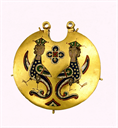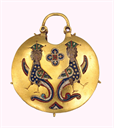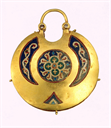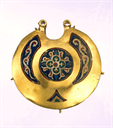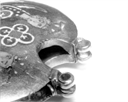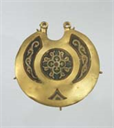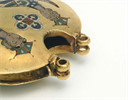Description
Kolti are impressive pendants that hung on chains from the hair or from a cap along the side of the face. The large size and convex sides of kolti have suggested that their hollow interiors might have contained perfumed cloth or cotton, the scent of which would permeate the air as the kolti swung with the movement of the wearer’s head. This interpretation is uncertain, however, as is the question whether there was a gender distinction as to wearers of the kolti. To date, only one archaeological find reveals that they were worn by a man and seem to have been attached to the flaps of a cap.
These kolti are decorated on both sides with cloisonné enamel. The obverse has addorsed sirens, mythological figures with the head of a woman and the body of a bird. They wear crowns similar to those on royal figures of the eleventh and twelfth century, although a relationship between these kolti and Kievan rulers cannot be established. The reverses have exuberant floral and geometric motifs, giving the pendants a dazzlingly colorful character. Seed pearls or beads were strung around the edge of each kolt, adding further ornamentation to these opulent works of art.
From 988, when Grand Prince Vladimir converted to Orthodox Christianity, until 1240, when Kiev was decimated by invading Mongolian Tartars, Kievan Rus’ was the strongest and richest polity north of Byzantium. Its wealth was derived from the plentiful natural resources available on the Eurasian continent, and its strength was bolstered by military and marriage alliances as well as mercantile connections with the European and Byzantine worlds. Along with adopting Constantinople as the model for a capital city, Kiev also adopted cloisonné enameling, one of Byzantium’s most coveted crafts, and made the skill its own.
S. Zwirn
Bibliography
J. P. v. Goidsenhoven, Adolphe Stoclet Collection, trans. F.C. Judson (Brussels, 1956), 310-313.
Sotheby's, Fine Decorative Arts: Medieval and Renaissance: Auction Wednesday 7 July 1999 (London, 1999), 16-17, no. 19.
M. C. Ross, Catalogue of the Byzantine and Early Mediaeval Antiquities in the Dumbarton Oaks Collection, Vol. 2, Jewelry, Enamels, and Art of the Migration Period, 2nd ed. with Addendum by S. A. Boyd and S. R. Zwirn (Washington, D.C., 2005), 220-226, no. 201A, pl. 132, colorpl. M.
G. Bühl, ed., Dumbarton Oaks: The Collections (Washington, D.C., 2008), 160, pl. p. 161.
L. V. Pekarskaja, B. Ager, and D. Kidd, Jewellery of Princely Kiev: the Kiev Hoards in the British Museum and The Metropolitan Museum of Art and Related Material, Monographien des Römisch-Germanischen Zentralmuseums (Mainz: London, 2011), 189.
L. Neville, Anna Komnene: The Life and Work of a Medieval Historian (New York: Oxford University Press, 2016), 129, fig. 7.1.
Acquisition History
Found in Kiev, 1909;
Collection of Adolphe Stoclet (1871-1949), Brussels, Belgium;
Purchased at Sotheby's London, lot 19, by Dumbarton Oaks Research Library and Collection, Washington, DC, July 7, 1999;
Dumbarton Oaks Research Library and Collection, Byzantine Collection, Washington, D.C.
